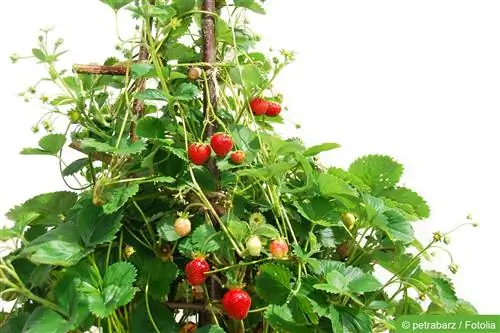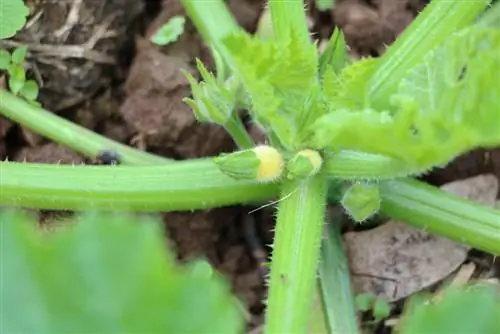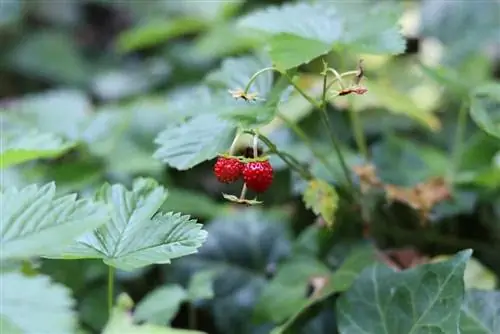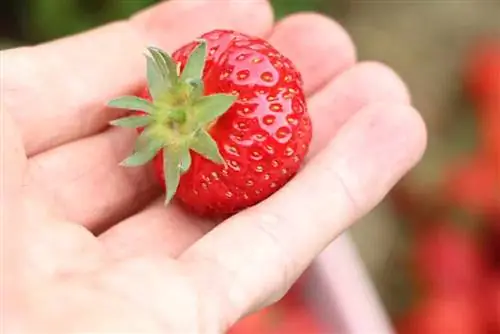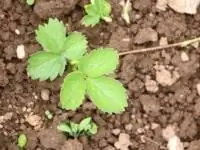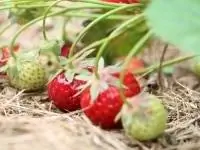- Author admin [email protected].
- Public 2023-12-17 03:39.
- Last modified 2025-01-24 12:45.
Climbing strawberries are popular with many because they can also be grown in containers or flower pots. Above all, these are still easy to care for, but the best results are still achieved in a bed. These plants also require a little space and should therefore be planted at a distance of 50 x 50 cm. Even if the name climbing strawberry suggests that it tends to climb upwards, this is not the case. Therefore, the shoots should be tied up on a climbing aid.
Soil and care
The climbing strawberries prefer normal to slightly acidic soil, but soil that is too chalky is unsuitable. Soils that are too light can be fertilized with bovine humus or compost and thus improved. For beautiful fruits, the climbing strawberry prefers a sunny location. Partial shade is just tolerated, but shady places are not acceptable at all. Up to 3 plants can be used in one plant pot, but it should have a circumference of 30 cm.
A lot of watering brings high yield
Strawberries always need moist soil, so they should be watered regularly. The first flowers should be broken off by June as this will result in a significantly higher yield. It is also important to remove the runners from young plants so that they become strong and can develop many tendrils. If these first runners are not removed, the plant will use too much energy for them and the yield will be correspondingly moderate. It is important not only that the soil is always moist, but that it is also fertilized regularly. A strawberry fertilizer or other liquid fertilizer is ideal for this. It should be noted that the dosage instructions must always be followed carefully, otherwise over-fertilization can occur.
Easily multiply climbing strawberries
These can simply be propagated via the shoots and so even more strawberries can be harvested. There is a variety that bears fruit in the first year and plenty of it. This is the Hummi variety, which bears a particularly large amount of and, above all, sweet fruit. Can be harvested from June until the first frost. So you can enjoy fresh strawberries again and again for a long time. The same care applies to this variety as to all climbing strawberries, as well as tying up. They are also not as susceptible to disease as normal strawberries. To propagate strawberries, simply cut off the shoots and plant them. Climbing strawberries are perennial plants, but after about two to three years they no longer produce as many fruits. Then it's good if there are replacements for the older plants.
Simply cut back before overwintering
After the last harvest, the plant must be removed from all shoots, flowers and leaves. Afterwards it can simply overwinter in a place protected from the wind. A spot near the wall of the house is particularly suitable if it is in a bucket. However, care must be taken to ensure that the plant does not get frost. Hay is suitable for this, as it then covers and warms the plant. It is important that the strawberry plant has enough moisture even during the winter. If no location can be found outdoors, this can also be in a stairwell. The only important thing is that no frost comes to the plant, otherwise it will no longer be able to grow in spring.
Important points to note:
- Sufficient distance between the individual plants
- Climbing help is necessary because these strawberries don't climb on their own
- Sunny location promises lots of fruit
- Watering and fertilizing regularly are important
- Remove shoots and possibly plant them
- Remove all leaves
- Frost-free place otherwise the plant will freeze
- Next spring the plant will sprout again on its own
If you follow these points, you will be able to harvest delicious strawberries for a few months of the year. Climbing strawberries are a real alternative, especially for people who don't have a garden. But especially if the first shoots are removed, these plants can grow really well. In a short time, the red fruits compete with the green foliage. Above all, these fruits are particularly sweet. But only if they had enough sun.
Easy to care for with great success
Especially since strawberries and especially climbing strawberries have little demands, even beginners can grow them successfully. The only requirement these places have is the floor. But if this is good, then only frost can stop these plants. Since the roots of climbing strawberries are not deep in the soil, they are even more susceptible to frost. These can freeze at -0.5 degrees. It is therefore important to get them protected over the winter before the first frost occurs. In spring they only need the sun and fertilizer and water at regular intervals. Then there are delicious fruits again. Propagation does not place any special demands on the gardener and so one plant is enough to produce many new ones. Because the first shoots always have to be removed.
Suitable for outdoors and containers

Of course, better results are achieved outdoors, but the harvest is still plentiful in the container. Harvesting can begin in June and is plentiful for many varieties of climbing strawberries. Above all, many varieties are less susceptible to pests and are self-pollinating. So they don't even need bees.
Plants & Care
Normal, slightly acidic soil is suitable as a plant substrate. Limestone soil is unsuitable. Light soils can be improved with compost and bark humus. The location is ideally sunny to partially shaded at most.
There is space for 3 plants in a plant pot with a diameter of 30 cm.
Espalier strawberries require a climbing frame, which must be around 1.50 meters high. Climbing spirals are also well suited. The runners need to be tied down. It is best to break out the flowers by June to achieve a larger harvest.
The first runners should be removed from all young plants. This is the only way compact plants with many tendrils can develop.
The soil must always be kept moist. Fertilize with liquid fertilizer every 14 days. There is also special strawberry fertilizer that is well suited. Always pay attention to the correct dosage. This is usually on the packaging.
The climbing strawberry can be propagated via the vines.
If you believe the advertising, climbing strawberries literally grow in your mouth. Try it!
Varieties
- ‘Hummi®’ is considered the best climbing strawberry.
- It has particularly sweet and lots of fruits.
- It produces flowers and fruits in the year it is planted.
- The climbing strawberry does not climb on its own, but must be tied high.
- Fruits from June to frost.
- Less rot diseases than other varieties.
- Self-fruitful
- The climbing strawberry 'Mountainstar' is also recommended
- Also an everbearing variety.
- Mid-early to mid-late monthly strawberries - so harvest from mid-June until frost
Tips
- Although strawberries are weak eaters, they should still be fertilized from time to time. Nettle manure is cheap. It is the natural fertilizer par excellence, easy to produce and free.
- Other organic fertilizers such as horn meal, manure or compost can also be used.
- Horse manure is said to work wonders on strawberries!
- It is important to pay attention to pest infestation and diseases!
- Both aphids and slugs like strawberry plants and some varieties are also susceptible to disease.
- In winter, protect the containers from severe frosts with fleece.
- Winter protection is also recommended for planted specimens.
- A protected location is best, but you shouldn't forget to water every now and then!
- Climbing strawberries are most easily propagated via foothills. This way you never have to buy new plants.
- The more strawberry plants you have in a planting container, the more you have to water and fertilize
Conclusion
Climbing strawberries are a great thing for anyone who wants to harvest plenty of fruit but doesn't have much space. They can of course be cultivated in a pot, but they need plenty of space and a lot of water. More fruit can be expected in the bed. The location should be sunny, but the hotter it is, the more watering is required. Climbing strawberries don't need much care. However, you shouldn't expect that the strawberry towers from catalogs will be so great on your patio at home. Unfortunately, these are just promises from the sellers, which are true in very few cases. Nevertheless, climbing strawberries are something great.

